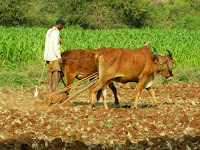The rise in methane concentration in the atmosphere may reflect the growth of agriculture to feed Asia’s booming population, according to a study published Thursday in the journal Science.
Rice paddies in Southeast Asia and livestock in India and China are probably behind the increase, according to researchers. The study was led by Hinrich Schaefer, an atmospheric scientist at the National Institute of Water and Atmospheric Research in Wellington, New Zealand. The findings were based on a chemical analysis of methane in the atmosphere.
Other scientists, however, challenged the results, arguing that the fracking-driven U.S. oil and gas boom is more likely to be the cause. Scientists have been trying to discover why methane levels in the atmosphere started rising in 2007 after holding steady for nearly a decade. As a greenhouse gas, methane is 84 times more potent than carbon dioxide over 20 years. Reducing methane emissions is considered crucial to slowing global warming.
...
Daniel Jacob, a professor of atmospheric chemistry and environmental engineering at Harvard University, questioned how such a large increase could come from livestock in Asia.
"You could say we have more livestock because we have more people to feed and people eat more meat, but you look at the increase in the number of head of livestock, and that doesn’t really account for the increase in methane," he said.
Jacob co-authored a separate study based on satellite data and surface observations last month in the academic journal Geophysical Research Letters. The study found that U.S. methane emissions could account for 30 to 60 percent of the global growth of atmospheric methane over the past decade.
Jacob’s work doesn’t pinpoint the source of the emissions but suggests leaks from the oil and gas industry may be the cause. The study notes that other researchers have recently observed increases in atmospheric concentrations of ethane. Ethane is a component of natural gas. If both methane and ethane are rising, natural gas is likely the source, Jacob said.
A peer-reviewed, satellite-based study published in 2014 found a significant increase in methane emissions from North Dakota and Texas where oil and gas production from the Bakken and Eagle Ford formations had been expanding rapidly. The study provides further evidence that the methane increase is from the oil and gas industry, Howarth said.
Read more at The Mystery of the Global Methane Rise: Asian Agriculture or U.S. Fracking?

No comments:
Post a Comment